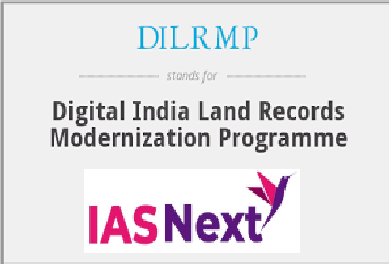CURRENT AFFAIRS
Get the most updated and recent current affair content on Padhaikaro.com
Digital India Land Record Modernisation Programme
- IAS NEXT, Lucknow
- 19, Nov 2021

Reference News
Recently, the Ministry of Rural Developmentinaugurated ‘Bhumi Samvaad’ – National Workshop on Digital India Land Record Modernisation Programme (DILRMP).
- The Ministry also launched the National Generic Document Registration System (NGDRS) portal and Dashboard.
Key Points
- Launch:
- The DILRMP was approved by the Cabinet on 21st August, 2008.
- For modernization of land records system in the country, a modified programme, viz., the National Land Records Modernization Programme (NLRMP), now renamed as Digital India Land Records Modernization Programme (DILRMP), has been formulated.
- Two centrally sponsored schemes of Computerization of Land Records (CLR) and Strengthening of Revenue Administration and updating of Land Records (SRA&ULR) were merged.
- About:
- It is a Central Sector scheme that has been extended to 2023-24, to complete its original targets as well as expand its ambit with a slew of new schemes.
- It attempts to build upon the commonalities that exist in the arena of land records in various States to develop an appropriate Integrated Land Information Management System (ILIMS) across the country, on which different States can also add State-specific needs as they may deem relevant and appropriate.
- ILIMS: The system contains information on parcel ownership, land use, taxation, location boundaries, land value, encumbrances and many more.
- It is being implemented by the Department of Land Resources (Ministry of Rural Development)
- Aim:
- To usher in a system of updated land records, automated and automatic mutation, integration between textual and spatial records, inter-connectivity between revenue and registration, to replace the present deeds registration and presumptive title system with that of conclusive titling with title guarantee.
- Components:
- Computerization of land records.
- Survey/re-survey.
- Computerization of Registration.
- Modern record rooms/land records management centres at tehsil/taluk/circle/block level.
- Training & capacity building.
- Benefits:
- Real-time land ownership records will be available to the citizen.
- Free accessibility to the records will reduce interface between the citizen and the Government functionaries, thereby reducing rent seeking and harassment.
- Public-Private Partnership (PPP) mode of service delivery will further reduce citizen interface with Govt. machinery, while adding to the convenience.
- The single-window service or the web-enabled “anytime-anywhere” access will save the citizen time and effort in obtaining RoRs (Record of Rights), etc.
- Automatic and automated mutations will significantly reduce the scope of fraudulent property deals.
- Conclusive titling will also significantly reduce litigation.
- Certificates based on land data (e.g., domicile, caste, income, etc.) will be available to the citizen through computers.
- This method will permit e-linkages to credit facilities.
- Information on eligibility for Government programs will be available, based on the data.
- Other Related Initiatives:
- National Generic Document Registration System:
- It is a major shift from the existing manual registration system to online registration of all transactions in sale-purchase and transfer of land.
- It is a big step towards National Integration and a leap towards ‘One Nation One Software’.
- Unique Land Parcel Identification Number:
- Being described as “the Aadhaar for land”, it is a number that would uniquely identify every surveyed parcel of land and prevent land fraud, especially in the hinterlands of rural India, where land records are outdated and often disputed.
- National Generic Document Registration System: